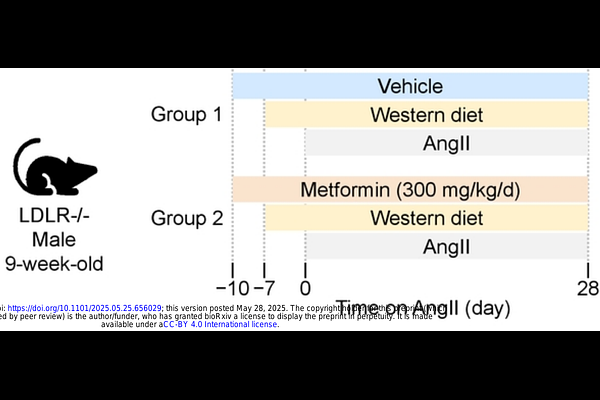Metformin Does Not Attenuate Angiotensin II-Induced Aortic Aneurysms in Low-Density Lipoprotein Receptor Deficient Mice

Metformin Does Not Attenuate Angiotensin II-Induced Aortic Aneurysms in Low-Density Lipoprotein Receptor Deficient Mice
Tyagi, S.; Ito, S.; Hubbuch, J.; Franklin, M.; Howatt, D.; Lu, H.; Daugherty, A.; Sawada, H.
AbstractBackground: Metformin, a biguanide antihyperglycemic agent, prevents angiotensin II (AngII)-induced abdominal aortic aneurysm formation in apolipoprotein E-deficient (ApoE-/-) mice. Low-density lipoprotein receptor-deficient (LDLR-/-) mice are also widely used as a hypercholesterolemic model, which more closely mimics the lipoprotein profile of patients with hypercholesterolemia than ApoE-/- mice. In addition, LDLR-/- mice exhibit characteristics of glucose metabolism that are distinct from ApoE-/- mice. However, it remains unknown whether metformin suppresses AngII-induced aortic aneurysm formation in LDLR-/- mice. Methods: Male LDLR-/- mice at 9 weeks of age were administered either vehicle or metformin in drinking water and fed a Western diet. Subsequently, AngII was infused into mice for 4 weeks. Plasma metformin concentrations were measured by mass spectrometry. Maximal aortic diameters and areas were measured ex vivo. Results: Mass spectrometry analysis determined plasma metformin concentrations in mice administered the drug. Metformin administration resulted in lower body weight compared to the vehicle group, indicating effective metformin administration. However, ex vivo measurements demonstrated that metformin did not reduce aortic diameters in the suprarenal abdominal region. In addition, metformin failed to prevent AngII-induced ascending aortic dilatations. Conclusion : Metformin did not attenuate AngII-induced aortic aneurysm formation in either the ascending or suprarenal abdominal region of LDLR-/- mice.